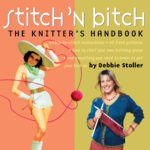 What are the latest trends in knitting? How can amateur knitters take it to the next level? And most importantly, what do you bitch about when you stitch? Stitch ‘N Bitch author Debbie Stoller answers all these burning questions, and more!
What are the latest trends in knitting? How can amateur knitters take it to the next level? And most importantly, what do you bitch about when you stitch? Stitch ‘N Bitch author Debbie Stoller answers all these burning questions, and more!
Q: Your new book is titled STITCH ’N BITCH SUPERSTAR KNITTING: Go Beyond the Basics, and it features a variety of different techniques, from lace-making to intarsia to beading and embroidery. Is this just for advanced knitters? How did you go about choosing the techniques?
A: The book is not so much for people who are advanced knitters as it is for people who want to become advanced knitters—the book is intended to help any knitter become a knitting superstar. So many people have taken up knitting in the past ten years, and lots of them are ready to move way beyond the scarf. The fact is that once you become comfortable with the two basic knit stitches—knit and purl—knitting plain sweaters and hats becomes really boring. You want to liven things up a bit—and it’s probably for this same reason that knitters of long ago invented things such as adding cable to their knitting, or doing all kinds of amazing things with color work, or even figuring out how to knit super-intricate lace. In the book I teach all of these techniques so that anyone can kick their knitting up a notch, whether they decide to try to learn all of these new skills or just a few. I chose the techniques that I felt were the most central to expanding your knitting abilities, and also included instructions on how to design your own patterns.
Q: What inspired you to take up knitting in the first place?
A: This is quite a long story, actually, but basically, my mother is from Holland, and I come from a long line of Dutch knitters and needle workers. I learned all sorts of needle skills as a child—sewing, embroidery, everything—but knitting was the one thing I hated. As I grew older I kept trying to pick up knitting and kept hating it, and then there was a long period where I kind of had to keep my crafting in the closet, as it just wasn’t considered very cool or even feminist to do so. But in the late ’90s, I realized it was time to give value to the skills of our mothers and grandmothers, and we began printing craft projects in the feminist magazine that I edit, BUST. Then, when I had to go cross country on a book tour for a book that we wrote that was based on the magazine, I decided to do it by train. Afraid that I’d be bored sitting on a train for three days straight, I decided to take a sweater with me that I’d been struggling with for . . . oh, about five years. It was a very easy sweater, but I hated knitting so much I could only work on it for about half an hour before I’d get so frustrated I’d put it away again for a year or so. Anyway, on the train ride I took out that sweater and picked up my knitting needles, looked over a knitting book for children I had taken with me, and suddenly, everything clicked. The rhythm of the train and the rhythm of my needles—everything just felt right. By the time I got to the West Coast the sweater was done, and I was hooked.
Q: Where do you see knitting going from here? Are there any new trends that we should look out for?
A: Right now lace knitting seems to be super-hot among knitters, and that comes on the heels, literally, of the previous trend, which was sock knitting. What will be the next trend among knitters? I don’t know. I’d like to see folks beginning to make nicely fitted sweaters in finer yarns, like they did in the old days. In fact, every new trend in knitting is really just a new generation discovering centuries-old techniques. I’m not sure there will ever be anything that’s truly new in knitting.
Q: The thought of knitting anything beyond a scarf can be quite intimidating to some people. Can you offer some advice on how first-time knitters can get started and what beginners who have mastered the scarf can do to take the next step?
A: The main thing that any new knitter needs to know is that learning to knit takes time. You can’t expect to just learn the basic stitches and then finish up a scarf in an hour. It’s not just like gluing Popsicle sticks together. It’s a skill that takes time to learn—just like learning to play the guitar. You don’t go to your first guitar lesson and then cut a demo the next day. If you can have patience with yourself, and know that it is going to feel really awkward at first, but will eventually begin to feel more comfortable, that’s all you need. And as for taking your knitting to the next level, the same thing applies. Knitters who have felt completely comfortable with the yarn and needles in their hands may feel like they are back to square one when they try to knit with two colors of yarn at the same time. But that, too, becomes more comfortable with practice. Mostly, all knitters should know that there isn’t anything they can’t do if they are just patient enough with themselves to get through the awkwardness. It’s not like dancing, which maybe you have to have some sort of a talent for. It’s something that anyone can learn.
Q: A diverse pool of talented people from all over the world contributed patterns to this book. How did you find them? Are there any states or countries that you have noticed knit more than others?
A: Well, obviously, in the states where it’s colder people tend to knit a bit more than in places where it’s warmer, simply because we have more opportunities to wear what we’ve created. And as for countries, right now there isn’t any country where knitting is as popular as it is in the United States. It’s been picking up over the years in the UK and Australia, there are lots of Stitch ’n Bitch groups in both of those places, and in Holland as well, but in other European countries it’s still seen as something that only grandmothers ought to do, and I don’t really know what it’s like in Asia, Africa, the Middle East, or in South America, although I do know that each of those regions also have a few active Stitch ’n Bitch groups going. There’s even an active Stitch ’n Bitch group in Dubai.
Q: What do you bitch about when you stitch?
A: Well, it could be anything, really, from the latest celebrity gossip to current events to politics. But really, if there’s bitching going on, it’s most often about the stitching itself. For instance, if someone realizes they made a mistake a long time ago in their knitting and have to rip out an hour’s worth of work—there will be some bitching, I’ll tell you.





No Comments